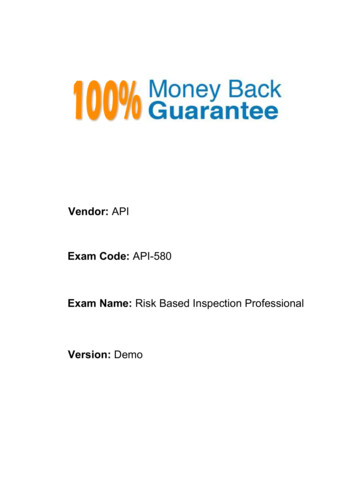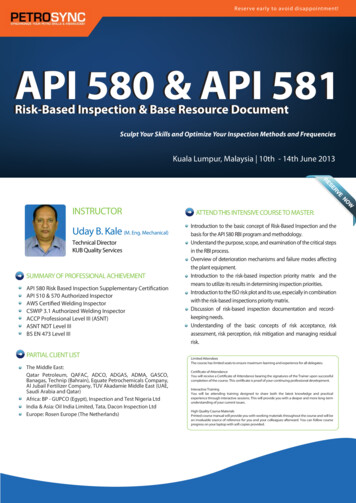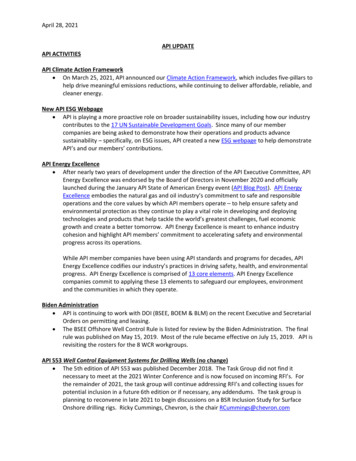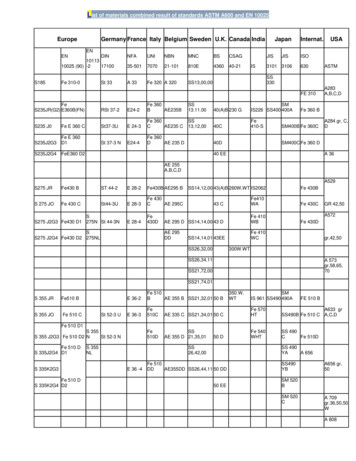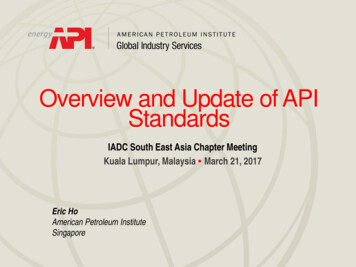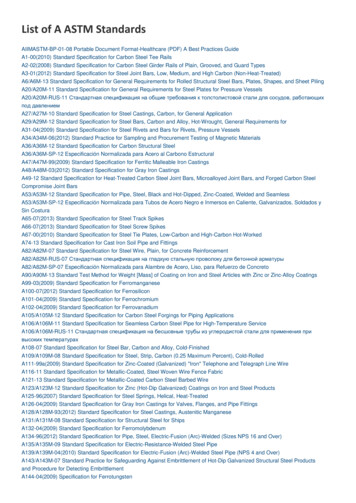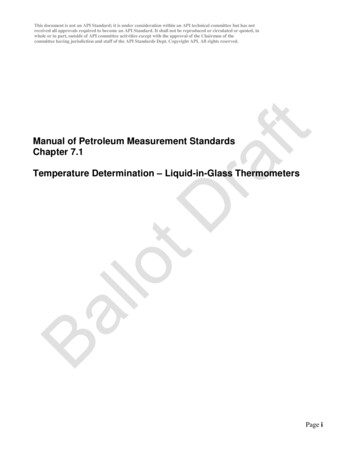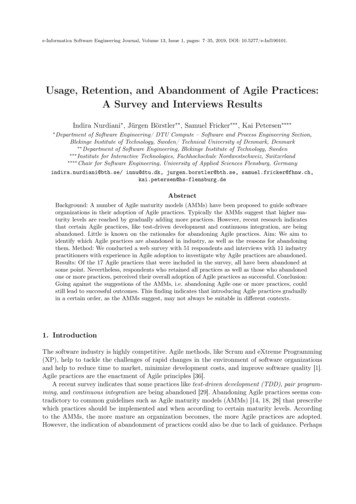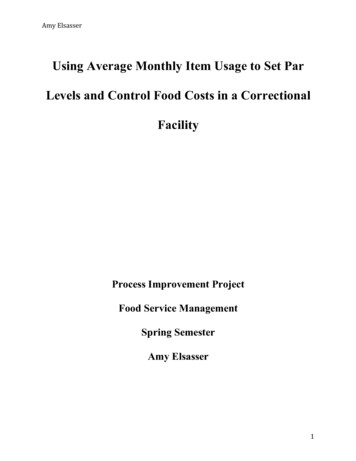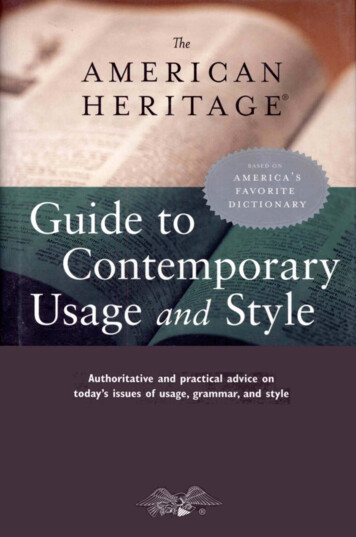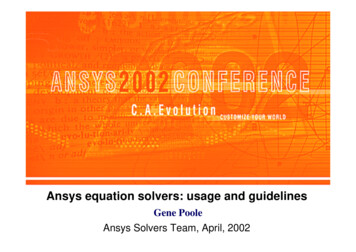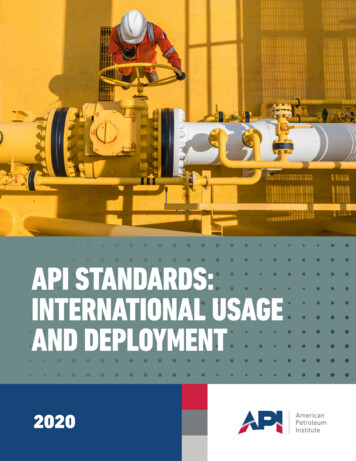
Transcription
API STANDARDS:INTERNATIONAL USAGEAND DEPLOYMENT2020
ACKNOWLEDGEMENTThis information was prepared by Crowell & Moring International (C&M International) in conjunction with API staff.API greatly appreciates the significant amount of work that went into this report, especially by C&M International andAPI’s global offices.For information, contact the API Standards Department at standards@api.org. 2020 American Petroleum Institute.All rights reserved. No part of this publication may be reproduced or used in any manner without the prior writtenpermission of the owner. While publisher has made reasonable efforts to present accurate and reliable information inthis report, publisher assumes no responsibility for any errors or omissions with the information contained herein. Noliability is assumed for damages that may result from the use of information contained. within.API International Standards ReportAcknoweledgement
TABLE OF CONTENTSINTRODUCTION AND EXECUTIVE SUMMARY . . . . . . . . . . . . . . . . . . . . . . . . . . . . . . . . . . . . . . . . . . . . . . . . 1AMERICAS. . . . . . . . . . . . . . . . . . . . . . . . . . . . . . . . . . . . . . . . . . . . . . . . . . . . . . . . . . . . . . . . . . . . . . . . . . . . . 4Argentina . . . . . . . . . . . . . . . . . . . . . . . . . . . . . . . . . . . . . . . . . . . . . . . . . . . . . . . . . . . . . . . . . . . . . . . . . . . . . . . . . . . 4Brazil. . . . . . . . . . . . . . . . . . . . . . . . . . . . . . . . . . . . . . . . . . . . . . . . . . . . . . . . . . . . . . . . . . . . . . . . . . . . . . . . . . . . . . . 8Canada . . . . . . . . . . . . . . . . . . . . . . . . . . . . . . . . . . . . . . . . . . . . . . . . . . . . . . . . . . . . . . . . . . . . . . . . . . . . . . . . . . . . 13Colombia. . . . . . . . . . . . . . . . . . . . . . . . . . . . . . . . . . . . . . . . . . . . . . . . . . . . . . . . . . . . . . . . . . . . . . . . . . . . . . . . . . . 21Ecuador. . . . . . . . . . . . . . . . . . . . . . . . . . . . . . . . . . . . . . . . . . . . . . . . . . . . . . . . . . . . . . . . . . . . . . . . . . . . . . . . . . . . 25Guyana . . . . . . . . . . . . . . . . . . . . . . . . . . . . . . . . . . . . . . . . . . . . . . . . . . . . . . . . . . . . . . . . . . . . . . . . . . . . . . . . . . . . 27Mexico. . . . . . . . . . . . . . . . . . . . . . . . . . . . . . . . . . . . . . . . . . . . . . . . . . . . . . . . . . . . . . . . . . . . . . . . . . . . . . . . . . . . . 29CENTRAL ASIA & THE MIDDLE EAST . . . . . . . . . . . . . . . . . . . . . . . . . . . . . . . . . . . . . . . . . . . . . . . . . . . . . 40Azerbaijan . . . . . . . . . . . . . . . . . . . . . . . . . . . . . . . . . . . . . . . . . . . . . . . . . . . . . . . . . . . . . . . . . . . . . . . . . . . . . . . . . 40Egypt. . . . . . . . . . . . . . . . . . . . . . . . . . . . . . . . . . . . . . . . . . . . . . . . . . . . . . . . . . . . . . . . . . . . . . . . . . . . . . . . . . . . . . 42Special Note: Gulf Cooperation Council. . . . . . . . . . . . . . . . . . . . . . . . . . . . . . . . . . . . . . . . . . . . . . . . . . . . . . . . 44Bahrain. . . . . . . . . . . . . . . . . . . . . . . . . . . . . . . . . . . . . . . . . . . . . . . . . . . . . . . . . . . . . . . . . . . . . . . . . . . . . . . . . . . . 46Kuwait. . . . . . . . . . . . . . . . . . . . . . . . . . . . . . . . . . . . . . . . . . . . . . . . . . . . . . . . . . . . . . . . . . . . . . . . . . . . . . . . . . . . . 47Qatar. . . . . . . . . . . . . . . . . . . . . . . . . . . . . . . . . . . . . . . . . . . . . . . . . . . . . . . . . . . . . . . . . . . . . . . . . . . . . . . . . . . . . . 49Oman. . . . . . . . . . . . . . . . . . . . . . . . . . . . . . . . . . . . . . . . . . . . . . . . . . . . . . . . . . . . . . . . . . . . . . . . . . . . . . . . . . . . . . 51Saudi Arabia. . . . . . . . . . . . . . . . . . . . . . . . . . . . . . . . . . . . . . . . . . . . . . . . . . . . . . . . . . . . . . . . . . . . . . . . . . . . . . . . 53United Arab Emirates (UAE) . . . . . . . . . . . . . . . . . . . . . . . . . . . . . . . . . . . . . . . . . . . . . . . . . . . . . . . . . . . . . . . . . .55INDO-PACIFIC . . . . . . . . . . . . . . . . . . . . . . . . . . . . . . . . . . . . . . . . . . . . . . . . . . . . . . . . . . . . . . . . . . . . . . . . . 56Australia. . . . . . . . . . . . . . . . . . . . . . . . . . . . . . . . . . . . . . . . . . . . . . . . . . . . . . . . . . . . . . . . . . . . . . . . . . . . . . . . . . . 56China . . . . . . . . . . . . . . . . . . . . . . . . . . . . . . . . . . . . . . . . . . . . . . . . . . . . . . . . . . . . . . . . . . . . . . . . . . . . . . . . . . . . . . 58India. . . . . . . . . . . . . . . . . . . . . . . . . . . . . . . . . . . . . . . . . . . . . . . . . . . . . . . . . . . . . . . . . . . . . . . . . . . . . . . . . . . . . . . 61Indonesia . . . . . . . . . . . . . . . . . . . . . . . . . . . . . . . . . . . . . . . . . . . . . . . . . . . . . . . . . . . . . . . . . . . . . . . . . . . . . . . . . . 65Japan. . . . . . . . . . . . . . . . . . . . . . . . . . . . . . . . . . . . . . . . . . . . . . . . . . . . . . . . . . . . . . . . . . . . . . . . . . . . . . . . . . . . . . 74Malaysia. . . . . . . . . . . . . . . . . . . . . . . . . . . . . . . . . . . . . . . . . . . . . . . . . . . . . . . . . . . . . . . . . . . . . . . . . . . . . . . . . . . 75Singapore. . . . . . . . . . . . . . . . . . . . . . . . . . . . . . . . . . . . . . . . . . . . . . . . . . . . . . . . . . . . . . . . . . . . . . . . . . . . . . . . . . 78Viet Nam. . . . . . . . . . . . . . . . . . . . . . . . . . . . . . . . . . . . . . . . . . . . . . . . . . . . . . . . . . . . . . . . . . . . . . . . . . . . . . . . . . . 80SUB-SAHARAN AFRICA . . . . . . . . . . . . . . . . . . . . . . . . . . . . . . . . . . . . . . . . . . . . . . . . . . . . . . . . . . . . . . . . 84Angola. . . . . . . . . . . . . . . . . . . . . . . . . . . . . . . . . . . . . . . . . . . . . . . . . . . . . . . . . . . . . . . . . . . . . . . . . . . . . . . . . . . . . 84Nigeria. . . . . . . . . . . . . . . . . . . . . . . . . . . . . . . . . . . . . . . . . . . . . . . . . . . . . . . . . . . . . . . . . . . . . . . . . . . . . . . . . . . . . 86
INTRODUCTION ANDEXECUTIVE SUMMARYStandards and technical regulations are essential drivers of economic growth, technology development, and globaltrade. In the energy sector, industry standards play a critical role in the development and spread of technologies andproducts used around the world every day to enhance environmental, health, safety, and sustainability performance.While there are many standards developing organizations (SDOs) globally, this can lead to many duplicative and/or competing standards used throughout the oil and natural gas industry. Ultimately, lack of alignment in the useof standards can create inefficiencies and divergences that result in unnecessary barriers and reduced economiccompetitiveness.API is a global leader in convening subject matter experts across segments to establish, maintain, and distributeconsensus standards for the oil and gas industry. API’s goal is to enhance operational safety, environmentalprotection and sustainability across the industry, especially through these standards being adopted globally. APIstandards are developed under API’s American National Standards Institute (ANSI) accredited process, ensuringthat the API standards are recognized not only for their technical rigor but also their third-party accreditation whichfacilitates acceptance by state, federal, and increasingly international regulators.This Report describes the use of API standards by national regulators and standards setting bodies in 25 markets,including Americas: Argentina, Brazil, Canada, Colombia, Ecuador, Guyana, and Mexico Central Asia and Middle East: Azerbaijan, Bahrain, Egypt, Kuwait, Oman, Qatar, Saudi Arabia, United Arab Emirates(UAE); Indo-Pacific: Australia, China, India, Indonesia, Japan, Malaysia, Singapore, Viet Nam; Sub-Saharan Africa: Angola and NigeriaThe 25 markets were chosen based on the current presence of the natural gas and oil industry, expected growthregions, and legislative considerations, such as the general use of standards in technical regulations by governments.Additionally, the report is meant to expand upon the 2010 OGP Report on Regulators’ Use of Standards, which covered15 markets (many of which were in the European Union), and the 2019 version of this report, which covered 17 markets.Since the 2010 OGP Report, there has been significant development and growth in the industry, including in manyemerging markets. For each of these 25 markets, API examined publicly available laws and regulations, databases ofnational standards and technical regulations, and operational manuals and industry practices to identify specific uses ofAPI standards.API International Standards ReportIntroduction and Executive Summary 1
Unlike the 2010 Report on Regulators’ Use of Standards, which covered overall use of technical standards incorporatedby reference in regulations and mainly focused on upstream standards, this Report is focused primarily on the use ofAPI standards across all segments — not only in national laws and regulations but also in policy guidance, nationalstandards, technical manuals, and industry practice.MAIN FINDINGS OF THE REPORT API standards are widely recognized and are used actively around the globe. Across the 25 markets, 789references to API standards were identified through an open source examination of laws, regulations, nationalstandards, technical guidance, and operational manuals. This likely underestimates use of API standards in thesemarkets, since a substantial portion of these markets’ standard-setting references are not openly available, anduse of API standards in some markets is governed by industry practice. References in national standards and technical regulations: Nearly 70% of the references to API standardsidentified were found within national standards and technical regulations. References to API standards werefound in the national standards and technical regulations of 18 of the countries analyzed: Indonesia (140),Canada (101), Brazil (50), Mexico (47), Colombia (41), Viet Nam (42), Guyana (22), Argentina (17), India (14),Singapore (14), Nigeria (13), China (11), Angola (9), Malaysia (8), Azerbaijan (8), Kuwait (4), Egypt (2), and Ecuador(2). These figures likely understate the use of API standards in national standards because many countries do notspecify when they adopt or model national standards after international standards, and this report examined onlythe national standards catalogues maintained by relevant authorities (rather than each standard individually). References in best practices or technical and operational manuals: Over 30% of references to API standardsidentified were found within best practices or technical and operational manuals issued by regulators ornational oil companies, indicating that API standards have widespread practical application. References to APIstandards were identified in guidance issued in Mexico (113), Nigeria (36), India (20), Argentina (20), Oman (13),Malaysia (13), Saudi Arabia (11), Indonesia (9), and Qatar (8). Beyond the textual references identified, API standards are widely used in industry practice in India and inthe Gulf Cooperation Council member countries (Bahrain, Kuwait, Oman, Qatar, Saudi Arabia, and United ArabEmirates). Industry reports, corroborated by sales data for API standards, indicate the uptake of API standards inIndia and the GCC countries is among the highest for the markets examined in this report. References to and use of API standards are not limited to a particular segment—they are widely used inregulations across upstream, midstream, and downstream sectors: 43% of API standards referenced pertained to upstream activities (exploration and production); 34% pertained to downstream activities (refining and marketing); 10% pertained to transportation; and 13% pertained to measurements, fire safety or environmental protection potentially applicable across multiplesegments. For 10 of the 25 countries, API standards were identified at a disparate rate within segments: In Canada, China, Malaysia, Saudi Arabia, and Qatar, API standards were more commonly found in the upstreamsector. In Mexico, Viet Nam, Singapore, Brazil, and Colombia, API standards were more commonly found in thedownstream sector.API International Standards ReportIntroduction and Executive Summary 2
For the remaining countries, API standards were identified at a roughly equivalent rate across upstream anddownstream segments.CONCLUSIONThe widespread use of API standards across all markets examined demonstrates the extent to which regulatorsand companies rely on them to enhance environmental, health, safety, and worker performance while stimulatingeconomic growth, technology development, and trade, in accordance with good regulatory practices. They are keyto the global energy sector, streamlining regulation across borders and minimize economic inefficiencies. As theglobal marketplace for natural gas and oil products and services continues to grow, there are opportunities for theindustry to collaborate with global companies, standards development organizations, and government agencies tofurther harmonization in the use of standards, technical cooperation and adoption of API standards and industry bestpractices.API International Standards ReportIntroduction and Executive Summary 3
AMERICASARGENTINAREGULATORY OVERVIEW AND STANDARDS FRAMEWORKThe primary
API 598, Valve Inspection and Testing API 599, Metal Plug Valves—Flanged, Threaded, and Welding Ends API 600, Steel Gate Valves - Flanged and Butt-welding Ends, Bolted Bonnets API 602, Gate, Globe, and Check Valves for Sizes DN 100 (NPS 4) and Smaller for the Petroleum and Natural Gas Industries API 623, Steel Globe Valves—Flanged and Butt-welding Ends, Bolted Bonnets .
![API Ballot: [Ballot ID] – API 510 & API 570, Deferrals, Rev05](/img/5/api510andapi570deferralsrev5.jpg)
